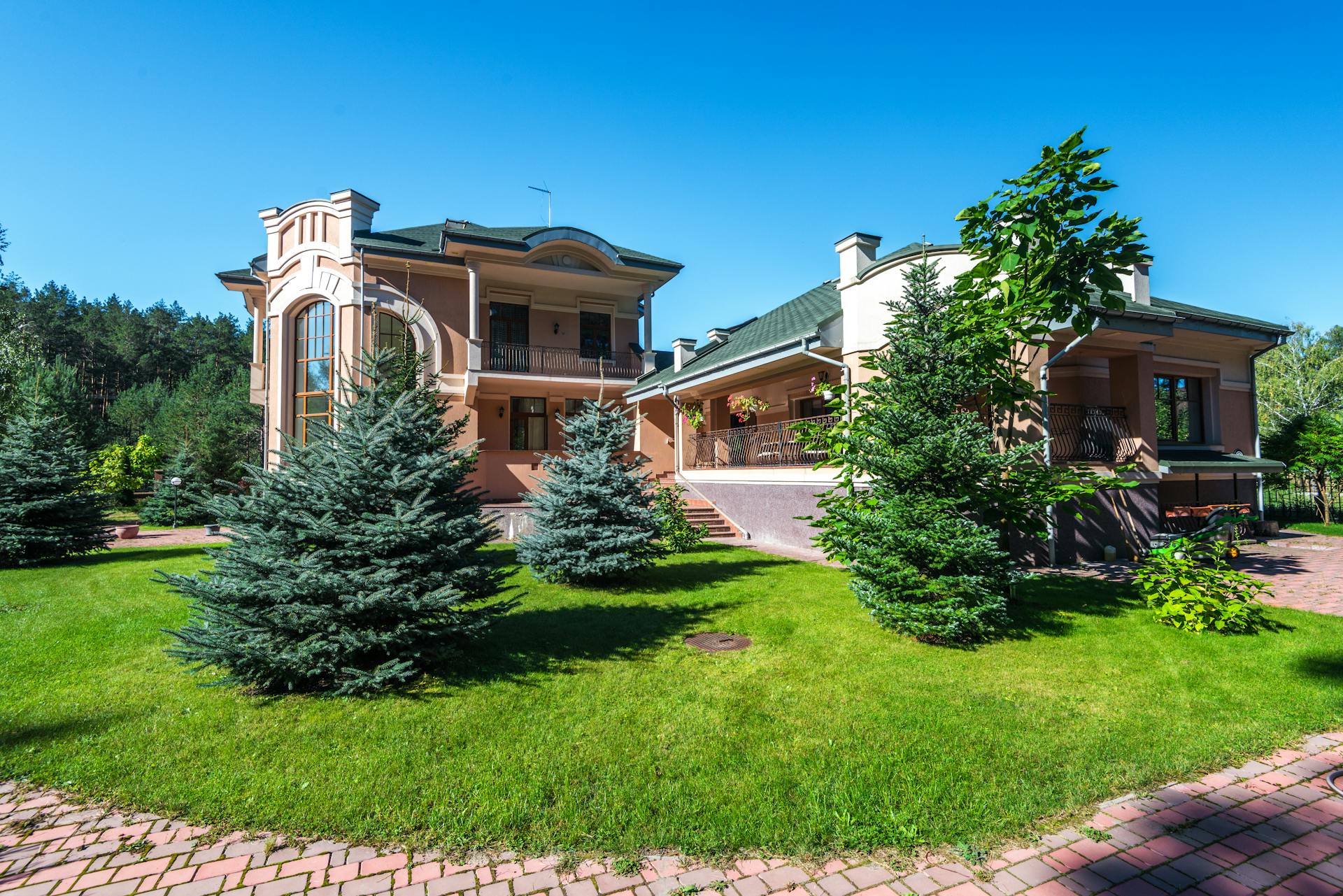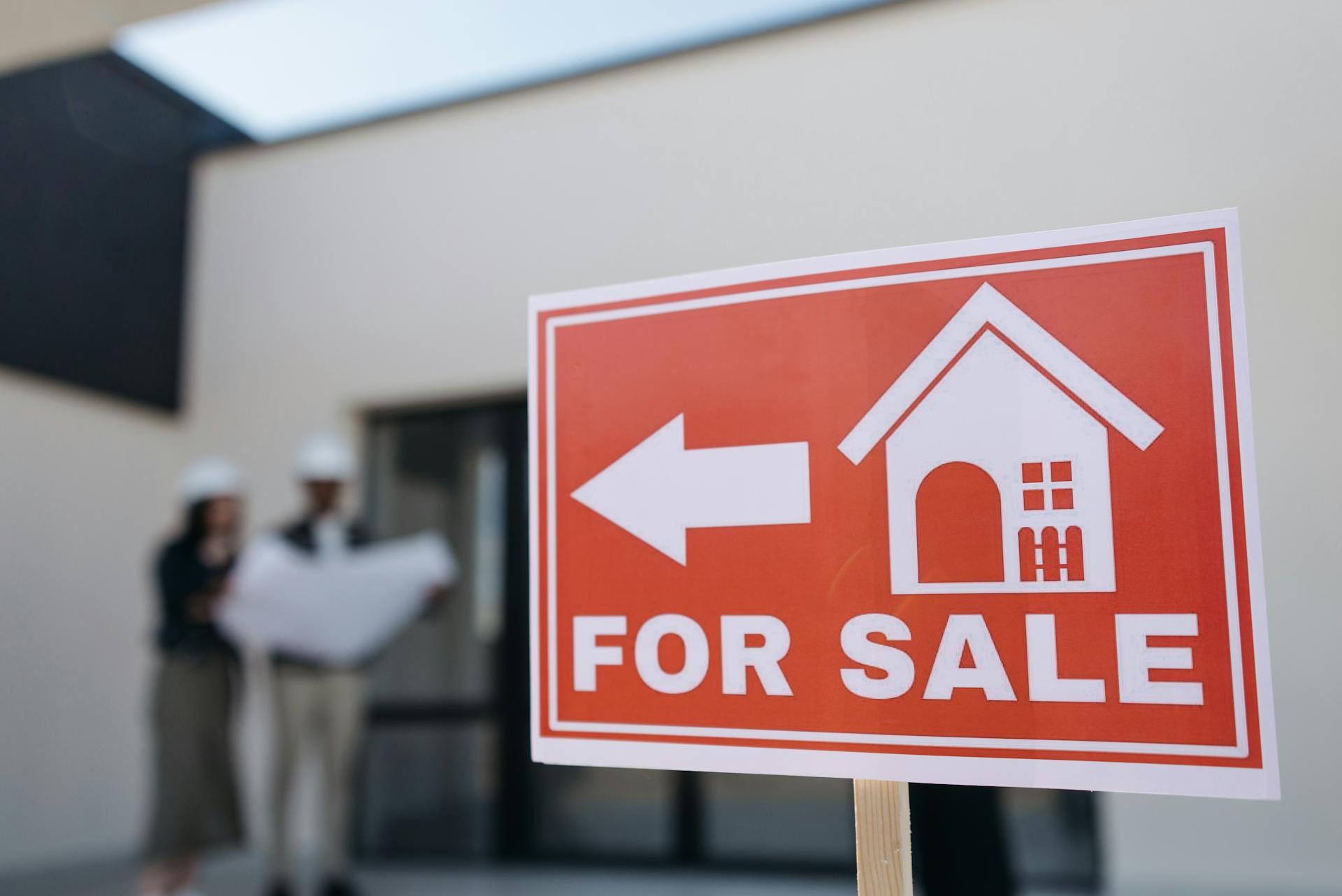
A Home Equity Line of Credit (HELOC) can be a valuable tool in real estate, but it's essential to understand the pros and cons before making a decision.
HELOCs allow homeowners to borrow against the equity in their home, typically up to 80% of the home's value.
The interest rate on a HELOC is often variable, which means it can change over time.
This can be a double-edged sword, as lower interest rates can save you money, but higher rates can increase your debt.
HELOCs often have a draw period, during which you can borrow money as needed, and a repayment period, during which you must pay back the loan.
The draw period can last anywhere from 5 to 10 years, depending on the lender.
HELOCs can be a convenient way to tap into your home's equity for large expenses, such as home renovations or paying off high-interest debt.
However, if you're not careful, you could end up owing more on your home than it's worth.
Here's an interesting read: Loan against Investment Account
What is a HELOC?
A HELOC, or Home Equity Line of Credit, is a type of loan that allows you to borrow money using the equity in your home as collateral. This means that the amount you can borrow is based on the value of your home minus any outstanding mortgage balance.
The interest rate on a HELOC is typically variable, which means it can change over time. For example, if the prime lending rate is 6%, your HELOC interest rate might be 6.25%.
A HELOC can be a great way to finance home improvements, pay off high-interest debt, or cover unexpected expenses. This is because the interest rate on a HELOC is often lower than a credit card or personal loan.
To qualify for a HELOC, you typically need to have a good credit score, a stable income, and a significant amount of equity in your home. For instance, if your home is worth $300,000 and you owe $150,000 on your mortgage, you might have $150,000 in equity.
You can usually borrow up to 80% of your home's value with a HELOC, although this can vary depending on the lender and your specific situation. This means that if your home is worth $300,000, you might be able to borrow up to $240,000.
A unique perspective: Internal Rate of Return Real Estate
Benefits and Drawbacks
A HELOC can be a useful tool in real estate, but it's essential to understand both its benefits and drawbacks. You can use a HELOC for home repairs and renovations, which can increase your home's value. With a HELOC, you could get a better rate than with an unsecured loan.
One of the benefits of a HELOC is that the interest on your loan may be tax-deductible if you use the money to buy, build or substantially improve your home. However, this is subject to certain conditions, such as the combination of the HELOC and your mortgage not exceeding stated loan limits.
A HELOC typically has variable interest rates, which can make it challenging to budget for payments that may change as the market fluctuates. On the other hand, a HELOC can be reusable, allowing you to repay and reuse the credit line as needed during the draw period.
Here are some key benefits and drawbacks of a HELOC:
Pros

A HELOC can be a great way to tap into your home's value for repairs and renovations, which can actually increase your home's worth. You could get a better rate with a HELOC than with an unsecured loan.
The interest on your HELOC may be tax-deductible if you use the money to make improvements to your home, and you meet certain IRS requirements. This can be a significant benefit, especially if you're planning to make major renovations.
Here are some key pros to consider:
- A HELOC is often used for home repairs and renovations, which can increase your home's value.
- You could get a better rate with a HELOC than with an unsecured loan.
- The interest on your HELOC may be tax-deductible if you use the money to improve your home.
These benefits make a HELOC an attractive option for homeowners who need access to cash for home improvements.
Cons
A HELOC may not be the right choice for everyone, and it's essential to consider the potential drawbacks before making a decision. One of the main cons is that it increases the risk of foreclosure if you can't pay the loan.
Many lenders, including Rocket Mortgage, don't offer HELOCs, which can limit your options. This might be a problem if you're looking for alternative financing options.

A HELOC is not recommended if your income is unstable or if you won't be able to afford payments if interest rates rise. This is because a HELOC's long borrowing and payment timeline can be challenging to manage during uncertain financial times.
It may not be the best choice if you're planning to move soon. You'll have to pay off the entire loan at the time of sale, which can be a significant burden if you're not planning to stay in the property long-term.
A HELOC may also not be the right choice if you aren't looking to borrow much money. In this case, the costs may not be worth it, and you should consider a low-interest credit card instead.
Pros and Cons
A HELOC can be a smart financial move, but it's essential to weigh the pros and cons before making a decision.
One of the main benefits of a HELOC is that it can be used for home repairs and renovations, which can increase your home's value.

You could get a better rate with a HELOC than with an unsecured loan, making it a more cost-effective option.
The interest on your HELOC may be tax-deductible if you use the money to buy, build or substantially improve your home, and the combination of the HELOC and your mortgage don't exceed stated loan limits.
Here are some key pros and cons to consider:
A HELOC can be a great option if you need to tap into your home's equity, but it's crucial to consider the potential risks and drawbacks.
You may be able to claim a tax deduction on the interest paid on your HELOC, but only if you use the funds to improve your home and meet the IRS requirements.

Drained equity is a significant con of a HELOC, as you'll lose a portion of the equity you've built in your property.
It's also essential to consider the costs and fees associated with a HELOC, which may be deducted from your credit line.
Ultimately, a HELOC can be a smart financial move if you're careful and consider all the pros and cons.
Is Interest Tax-Deductible?
You can deduct the interest on your HELOC if you use the funds to "buy, build or substantially improve" your home, and the combination of your HELOC and mortgage doesn't exceed the stated loan limits.
The IRS allows you to write off at least a portion of the interest on your home equity credit if you itemize deductions and meet certain requirements.
Couples who file jointly can deduct the interest on up to $750,000 of eligible mortgage debt, including home equity loans and HELOCs, as long as the debt is used for home improvements.
This rule applies to any HELOC, whether it was taken out on a primary home or an investment property.
If you're considering a HELOC for home repairs or renovations, keep in mind that the interest on your HELOC may be tax-deductible, which can help reduce your taxable income.
Here are the key facts to know about tax-deductible interest on HELOCs:
- Couples who file jointly can deduct interest on up to $750,000 of eligible mortgage debt.
- The debt must be used to "buy, build or substantially improve" the home against which it was secured.
- The interest on your HELOC may be tax-deductible if you use the funds for home improvements.
Getting a HELOC
Getting a HELOC involves several steps, including calculating your existing equity and deciding how much you need to borrow. You'll also need to gather necessary documentation, such as W-2s, recent pay stubs, and mortgage statements.
To start, calculate your existing equity by subtracting the amount you owe from the current value of your home. This will help you determine how much you can borrow. You can also use this calculation to decide how much you need to borrow.
Next, gather the necessary documentation to make the process smoother. This typically includes W-2s, recent pay stubs, mortgage statements, and personal identification. Having all the required documents in hand will save you time and hassle.
You might enjoy: Can You Borrow from Your Pension to Buy a House
Shopping around for lenders is crucial, as loans can vary significantly from one lender to another. You should get at least three quotes from different lenders, including banks, credit unions, and mortgage companies. Consider starting with your existing bank or financial institution, as they may offer special rates or incentives for existing customers.
Here are the typical requirements for getting a HELOC:
Finally, be aware that the underwriting process can take weeks, and you should carefully review your disclosure documents and ask the lender questions to ensure the HELOC fits your needs.
Rates and Fees
To get the best HELOC rate, you should shop around with at least three lenders. Check your bank or mortgage provider for potential discounts.
Shopping around can help you save money on interest rates. Introductory offers like initial rates that expire at the end of a given term can also be a good option.
Before opening a HELOC, consider lenders that offer a fixed-rate option. This can protect your loan from rising interest rates and make long-term financial planning easier.
Explore further: Whats a Good Student Loan Interest Rate
In addition to interest, there are further costs to consider before taking out a HELOC. Closing costs, which can range from 2% to 5% of the loan amount, are one of these costs.
Some lenders don't charge closing costs at all, but this can be contingent on keeping the line open for a certain amount of time. Annual fees of around $50 per year are another cost to consider.
Here's a breakdown of the costs you might incur with a HELOC:
- Closing costs: 2% to 5% of the loan amount
- Annual fees: around $50 per year
Every lender has their own way of judging risk, so you'll get slightly different rates and terms from each one. Total cost, including interest rate and fees, is crucial when deciding which loan works best for your budget.
Using a HELOC
You can use a home equity loan or HELOC for a wide range of purposes. From renovations and remodeling projects that add value to your home, to paying off high-interest debt, like credit card balances.
Renovations and remodeling projects can increase your home's value and make it more livable. You may also be eligible for a tax deduction, which is a nice bonus.
Paying off high-interest debt can save you money in the long run. The money you save may be more than worth the cost of the HELOC.
Alternatives and Considerations
If you're considering a HELOC on a rental property, it's worth exploring alternative options. A cash-out refinance, for example, allows you to refinance your rental property and receive the difference in cash.
This option typically comes with a lower interest rate and the freedom to use your funds as you see fit. You'll also only have one mortgage to worry about.
A HELOC on your primary residence is another viable option, but it's worth noting that it's easier to qualify for and often comes with a slightly lower interest rate. You'll need to meet the requirements, however.
Related reading: Find Paypal Option on Shop Pay Checkout
You can also consider a home equity loan, which can be a solid alternative to a HELOC. With a home equity loan, you'll receive a lump-sum payment that you can use to fund repairs or make an emergency payment.
If you're not eligible for a home equity loan, you might want to look into an unsecured personal loan. These loans offer a one-time lump sum, but you'll need to start making repayments right away.
Here are some alternative options to consider:
- Cash-out refinance: Refinance your rental property and receive the difference in cash.
- HELOC on your primary residence: Easier to qualify for and often comes with a lower interest rate.
- Home equity loan: Receive a lump-sum payment for repairs or emergency payments.
- Unsecured personal loan: Receive a one-time lump sum, but make repayments right away.
Alternatives to Rentals
If you're considering alternatives to rental properties, one option to explore is cash-out refinancing. This allows you to refinance your rental property at a higher loan amount and receive the difference in cash.
A cash-out refinance can provide more freedom with your funds and often comes with a lower interest rate compared to a HELOC. With this option, you'll only have one mortgage to manage.
Another alternative is to secure a HELOC on your primary residence, if you meet the requirements. This option is usually easier to qualify for and comes with a slightly lower interest rate.
Explore further: Seller Financing Rates
If you have enough equity in your investment property, a home equity loan can be a solid alternative to a HELOC. With this loan, you'll receive a lump-sum payment you can use for repairs or emergency payments.
Alternatively, you can consider an unsecured personal loan. If approved, you'll receive a one-time lump sum, and strong candidates may qualify for a lower interest rate.
Here are some key differences between these alternatives:
- Cash-out refinance: allows you to refinance a rental property at a higher loan amount and receive the difference in cash.
- HELOC on primary residence: usually easier to qualify for and comes with a slightly lower interest rate.
- Home equity loan: provides a lump-sum payment for repairs or emergency payments.
- Unsecured personal loan: provides a one-time lump sum, with potential for a lower interest rate.
Alternatives to Property
If a HELOC on an investment property isn't the right fit, there are several alternatives to consider.
You can use your primary residence as collateral for a HELOC, which often comes with less stringent requirements.
A home equity loan offers a fixed interest rate and a lump sum payout, making it a more predictable option.
A cash-out refinance replaces your investment property's current mortgage with a larger loan, potentially lowering your interest rate and providing a lump sum of cash.
Unsecured personal loans don't require home equity, but may come with higher interest rates.
Credit cards offer the flexibility to qualify based only on credit history, but often come with high variable interest rates.
If you have multiple investment properties, you can consider a cross-collateralization loan to pool your equity and access a larger credit line.
Here are some alternatives to a HELOC on an investment property:
- HELOC on a primary home: Less stringent requirements, same benefits
- Home equity loan: Fixed interest rate, lump sum payout
- Cash-out refinance: Replace mortgage with larger loan, potentially lower interest rate
- Personal loan: No home equity required, but potentially higher interest rates
- Credit card: Qualify based on credit history, but high variable interest rates
- Cross-collateralization loan: Pool equity from multiple properties for larger credit line
Differences between Primary Properties and Loans
When you take out a HELOC on your primary residence, you'll typically pay lower fees and interest rates compared to a HELOC on an investment property.
Lenders view investment property HELOCs as riskier because your cash flow is tied up in multiple rental properties, making you a higher risk for defaulting.
The fees and interest rates for investment property HELOCs are likely to be higher due to this perceived risk.
Investment property HELOCs differ from traditional HELOCs in several ways, including the risk assessment and resulting fees and interest rates.
The risk associated with investment property HELOCs is a key factor in determining the loan terms, making it essential to understand this difference before applying.
Frequently Asked Questions
What is the monthly payment on a $50,000 HELOC?
For a $50,000 HELOC, the monthly payment is approximately $384 for interest-only or $457 for principle-and-interest, depending on the payment plan.
What is the monthly payment on a $100,000 HELOC?
For a $100,000 HELOC with a 6% APR, monthly payments during the 10-year draw period are approximately $500. This estimate assumes only interest payments are required during this time.
Sources
Featured Images: pexels.com


